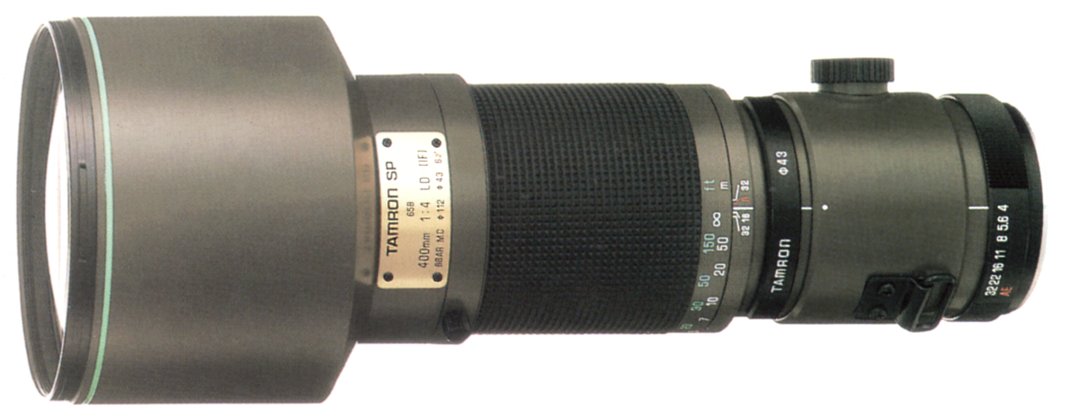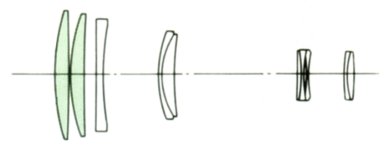|
Tamron SP 400mm F/4.0 LD-IF Model 65B: An exceptionally
sharp long telephoto lens with internal focusing and very robust internal
construction. This lens features two low dispersion (LD) elements (shown in
green in the above optical layout), internal focusing (IF), and a spherical
aberration compensator group (the doublet in the middle of the optical layout)
which assures crisp images at close focusing distances. The model 65B was
manufactured by Tamron for six years, but not very many were sold. This is
surprising when one considers that this lens provided exceptionally good
optical performance even when compared to similar OEM lenses! A combination of
poor marketing and this lens's very limited niche market for very serious
sports and nature photographers is the answer. Tamron's unique spherical
aberration compensator group, incorporated in all of their SP LD-IF manual
focus lenses, was introduced in 1979 within their SP 300mm F/5.6 telephoto
macro lens. Quite simply, the performance of this lens is excellent even when
compared to similar OEM lenses of the era and to today's similar OEM AF lenses.
Wide open at F/4, the SP 400 model 65B exhibits very good optical performance
with just a trace of softness but no other observable optical aberrations.
Optical performance is superb at F/5.6 and smaller apertures. Optical
performance with the SP 1.4X converter is good to very good. A heavy duty
tripod is a prerequisite for achieving excellent results with this lens. Many
professional photographers have lamented that Tamron discontinued this lens in
1995 and never produced a version for AF camera bodies.
Lens Specifications:
| Lens Model |
65B |
| Focal Length |
400mm |
| Aperture Range |
f/4 — 32, AE |
| Angle of View |
6.2° |
Optical
Construction
(Groups / Elements) |
7 / 10 |
| Min. Focus from Film
Plane |
118" (3.0m) |
| Macro Mag.
Ratio |
— |
| Filter Size |
43mm (rear), 112mm (front) |
| Diameter |
4.6" (118mm) |
Length at

[w/Nikon mount] |
11.5" (293mm)
[11.7" (297.5mm)] |
| Weight |
80.1 oz. (2270g) |
| Lens Hood |
Bayonet type #39FH, reversible. |
| Accessory |
Accepts SP 2X tele-converter #01F. Supplied
wth lens hood and SP 1.4X tele-converter #140F. Additional 43mm rear filters
and 112mm front filter available as optional extras. |
We haven't been able to find test reports for this lens performed
by any of the major photography magazines. Shown below are the test results
obtained by Gary Reese. Gary uses a very good test standard for judging the
relative performance of lenses which he tests — an Olympus 50mm f/2.0
Zuiko macro lens set to f/8. Thus Gary is uses "known good" images from the
Zuiko macro lens as a reference standard when examining images from other
lenses which he has tested. Gary's test results accord well with both Photodo's
test results and our own experiences with this lens.
| Tamron SP 400mm f/4 |
OM-1
with mirror lockup and second tripod supporting lens hood.
Vignetting = B- @
f/4, A- @ f/5.6
Distortion = none |
* All
tests photographed at a 1:40 magnification ratio, on Fujichrome 64T (original
type) film.
* Test subject: Grand Canyon National Park USGS topographic map
(1 to 1 2/3 stop underexposure from a grey card reading).
* Subjective
quality factor style grades are relative, with A+ = best, then B, C, D, and F
(worst); differences are significant across full letter grades only (unless a
paired comparison was made - as noted). Corner grades are measured at 66% out
from center and are less rigorous than center grades. An A+ grade for centers
and corners is set to the performance of a 50mm f/2.0 Zuiko Macro at
f/8.
|
| F/No. |
Center |
Corner |
Notes: |
| 4 |
B+ |
B+ |
A = "Tack
sharp" professional grade images with great enlarging or projection capability.
Approx. 20"x30" print size capability.
B = Very good images that will
satisfy all but the most discerning users; projected image quality is
indistinguishable from an A grade at normal viewing distances. Approx. 11x17"
enlargement capability.
C = "Soft" images that cannot withstand much
enlargement - suitable for snapshot quality images (5x7").
D = "Smudged"
with obvious image defects in even small degrees of enlargement, not suitable
for most users (only 3.5x5").
F = unacceptable image for any type of use,
lacks detail, only conveys shapes. |
| 5.6 |
A- |
B+ |
| 8 |
A |
B+ |
| 11 |
A+ |
A- |
| 16 |
A- |
A |
| 22 |
A- |
A- |
| 32 |
B |
B- |
| Gary's notes: High
contrast with remarkable image quality for a super telephoto, optimum aperture
appears to be f/11. |
|



